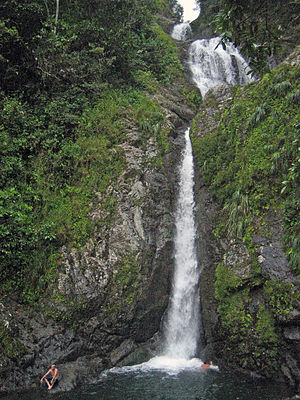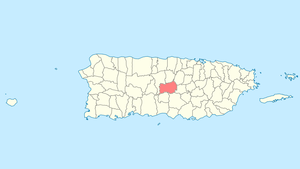Orocovis, Puerto Rico
Orocovis, Puerto Rico | ||
|---|---|---|
Town and Municipality | ||
 | ||
| ||
| Nickname(s): "Corazón de Puerto Rico", "El Centro Geográfico de Puerto Rico" | ||
| Anthem: "Mi patria es una bella isla" | ||
 Location of Orocovis in Puerto Rico | ||
| Coordinates: 18°13′37″N 66°23′28″W / 18.22694°N 66.39111°W / 18.22694; -66.39111Coordinates: 18°13′37″N 66°23′28″W / 18.22694°N 66.39111°W / 18.22694; -66.39111 | ||
| Country | United States | |
| Territory | Puerto Rico | |
| Founded | November 10, 1825 | |
| Government | ||
| • Mayor | Hon. Jesús E. Colón Berlingeri (PNP) | |
| • Senatorial dist. | 5 - Ponce | |
| • Representative dist. | 26 | |
| Area | ||
| • Total | 71.1 sq mi (184.17 km2) | |
| • Land | 71.0 sq mi (184 km2) | |
| • Water | 0.1 sq mi (0.17 km2) | |
| Population (2010) | ||
| • Total | 23,423 | |
| • Density | 330/sq mi (130/km2) | |
| Demonym(s) | Orocoveños | |
| Time zone | UTC-4 (AST) | |
| Zip code | 00720 | |
| Website | www.orocovispr.org | |

Near the main plaza, 1941
Orocovis (from Taino language, Orocobix meaning remembrance of the first mountain) is a municipality of Puerto Rico (U.S.) located in the Central Mountain Range, north of Villalba and Coamo; south of Morovis and Corozal; southeast of Ciales; east of Jayuya; and west of Barranquitas. Orocovis is spread over 17 wards and Orocovis Pueblo (the downtown area and the administrative center of the city). It is part of the San Juan-Caguas-Guaynabo Metropolitan Statistical Area.
Contents
1 History
2 Symbol
2.1 Flag of Orocovis
2.2 Coat of Arms
2.3 Nicknames
3 Geography
3.1 Barrios
4 Culture
4.1 "The Musical Capital of Puerto Rico"
4.2 Tourism
4.3 Landmarks and places of interest
4.4 Festivals and events
5 Economy
5.1 Agriculture
5.2 Industrial
6 Demographics
7 Government
8 Education
9 Transportation
10 See also
11 References
12 External links
History
Since before the Spanish colonization in the 16th century, Taíno Indians were already established in the Orocovis region. They were led by the cacique Orocobix and his group of Taino was known as the Jatibonicu. After Spaniards settled in the island, the region was called Barros and designated as a barrio of Barranquitas.
On May 25, 1825, the neighbors of the region granted Don Juan de Rivera Santiago the powers to request the Governor authorization to found a municipality in Barros, where they had bought almost 14 acres of land from Doña Eulalia de Rivera, who donated an additional acre to establish several municipal works. However, due to the distance from bodies of water, the settlement was moved to another place. On November 10, 1825, Governor Miguel de la Torre granted permission to found the new municipality of Barros.
In 1838, the parish of San Juan Bautista de Barros was created and was blessed and inaugurated on October 29 of the same year. However, on 1875, a fire destroyed the church, the King's House, the priest's house and several homes.
In 1928, the Legislative Assembly of Puerto Rico approved a resolution to change the name of Barros to Orocovis, to honor the Taíno cacique of the same name, who lived in that region.
Symbol
Flag of Orocovis
The Flag of Orocovis is formed by five vertical stripes: Two green stripes at the ends, representing the territories of Aibonito and Barranquitas; and a blue one in the center representing the regional domain of the cacique Orocobix prior to the Spanish colonization. These stripes are divided by two narrower white stripes, representing the territories granted by Barranquitas and Morovis to form the municipality in 1825.
Over the blue portion there's an oval with a sun. The sun has seventeen rays that represent the different regions of the town. The sun, being the center of our solar system, represents Orocovis as the center of the island of Puerto Rico.
Coat of Arms
The oval is symbol of the letter "O", initial of the name of the town. In each quadrant appear representative elements of the town. In the left superior quadrant a Taíno Indian bust, symbol of the great "Chief Orocobix" and the Indian heritage of the town, silhouetted in gold on a silver-plated background. The Indian bust faces towards the star or sun that appears in the superior right quadrant, which is in gold on a blue background and represents the territorial municipality with its seventeen rays or demarcations. In the inferior right quadrant, a plantain plant is observed representing the agriculture, silhouetted in gold on a silver-plated background. A bridge also silhouetted in gold on a blue background, above the river appears in the left inferior quadrant.
Nicknames
Most of Orocovis nicknames stem from its location in the center of the island. Some of them are: "Corazón de Puerto Rico" (Heart of Puerto Rico) and "Centro Geográfico de Puerto Rico" (Geographical Center of Puerto Rico). The center of the island of Puerto Rico is in a ward called "Pellejas", on Road 566, Km 5.7. Former sayings about the center of the Island being in front of the Catholic church was determined to be false by engineers from the University of Puerto Rico, Mayagüez Campus.
Geography
Most of the Orocovis terrain runs through the Cordillera Central of the island. Most of the high peaks are in the southern region of the town within the limits of the municipality with Villalba and Coamo. The highest peak of the town is Cerro Mogote.
The rivers Toro Negro, Sana Muertos, Orocovis, Matrullas, and Bauta, and the creeks Doña Juana, Palmar and Cacaos are among the water bodies in the town. There are two lakes: El Guineo, formed within de Toro Negro River, and the Matrullas Lake formed by the Bauta River. El Guineo is Puerto Rico's highest lake.[1]
Barrios
Like all municipalities of Puerto Rico, Orocovis is subdivided into barrios.[2][3][4]
- Ala de la Piedra
- Barros
- Bauta Abajo
- Bauta Arriba
- Bermejales
- Botijas
- Cacaos
- Collores
- Damián Abajo
- Damián Arriba
- Gato
- Mata de Cañas
- Orocovis
Orocovis barrio-pueblo[5]
- Pellejas
- Sabana
- Saltos
Culture
"The Musical Capital of Puerto Rico"
Orocovis is sometimes called "The Musical Capital of Puerto Rico" because many major Puerto Rican performers were either born or raised in the town, particularly bandleader Bobby Valentín, folk singer Andrés Jiménez, merengue singer Manny Manuel, salsa legend William "H. Christ" Corchado, and the Colón-Zayas family of musicians, which includes Emma (singer, multi-instrumentalist) and Edwin (a cuatro player).
Tourism
- Bosque Estatal de Toro Negro
- Las Picinas del Area Recreativa "Jesús M. (Tito) Colón Collazo (Tito Colón Pool, Spring Water and Recreative Park)
- Las Cabañas (The Ribs, Restaurant)
- Area Recreativa de Damian (Recreative park of Damian)
- Rios (Rivers)
- Vistas Panorámicas (Panoramic View)
- Lugares Recrativos (Passive Parks)
- Toro verde ( Ecological adventure park)
Landmarks and places of interest
- Indian Cave
- Matrullas Lake
- El Guineo Lake
- Orocovis Museum
- Taíno Refuge
- Mirador Villalba - Orocovis
- Bosque Toro Negro (Toro Negro Rain Forest)
- Area Recreativa Cerro La Guaira (Recreative Park)
- Salto Doña Juana (Doña Juana Water Fall)
- Toro Verde Nature Adventure Park
Festivals and events
Orocovis Fiestas Patronales are held in June. Other traditional festivals held at the city are the Infant Theater Festival in April; the Festival del Camarón in July; the Arts Craft Fair in September; and the National Festival of the Puerto Rican Pastel in November.
Economy
Agriculture
Cattle, coffee, fruits, tobacco, and wheat.
Industrial
Several small nutritional product industries
Demographics
| Historical population | ||
|---|---|---|
| Year | Pop. | ±% |
| 1899 | 14,845 | — |
| 1910 | 15,028 | +1.2% |
| 1920 | 15,758 | +4.9% |
| 1930 | 16,115 | +2.3% |
| 1940 | 19,770 | +22.7% |
| 1950 | 21,181 | +7.1% |
| 1960 | 20,362 | −3.9% |
| 1970 | 20,201 | −0.8% |
| 1980 | 19,332 | −4.3% |
| 1990 | 21,158 | +9.4% |
| 2000 | 23,844 | +12.7% |
According to the 2000 census, Orocovis has a population of 23,844 with a population density is 378.4 people per square mile (145.5/km²). Although there was a decline in the population during the 1980s, it has steadily increased during the last decades.
Statistics taken from the 2000 census shows that 81.4% of Orocoveños have Spanish or White origin, 4.1% are black, 0.4% are Amerindian etc.
| Race - Orocovis, Puerto Rico - 2000 Census[6] | ||
|---|---|---|
| Race | Population | % of Total |
| White | 19,401 | 81.4% |
| Black/African American | 975 | 4.1% |
| American Indian and Alaska Native | 87 | 0.4% |
| Asian | 15 | 0.1% |
| Native Hawaiian/Pacific Islander | 5 | 0.0% |
| Some other race | 2,618 | 11.0% |
| Two or more races | 743 | 3.1% |
Government
All municipalities in Puerto Rico are administered by a mayor, elected every four years. Jesús Colón Berlingeri (of the New Progressive Party) has served as mayor since 1998.
The city belongs to the Puerto Rico Senatorial district VI, which is represented by two Senators. In 2012, Miguel Pereira Castillo and Angel M. Rodríguez were elected as District Senators.[7]
Education
Orocovis counts with several public and private schools distributed through several regions. Public education is handled by the Puerto Rico Department of Education.
Transportation
There is no direct highway connection to Orocovis. Roads #137 and #155 lead from the north, while Roads #138 and 155 lead from the south. Orocovis lies at about 1.5 hours from the capital of San Juan.
See also
- List of Puerto Ricans
- History of Puerto Rico
- Did you know-Puerto Rico?
References
^ PR Off the Beaten Path. Page 156
^ Gwillim Law (20 May 2015). Administrative Subdivisions of Countries: A Comprehensive World Reference, 1900 through 1998. McFarland. p. 300. ISBN 978-1-4766-0447-3. Retrieved 25 December 2018..mw-parser-output cite.citation{font-style:inherit}.mw-parser-output .citation q{quotes:"""""""'""'"}.mw-parser-output .citation .cs1-lock-free a{background:url("//upload.wikimedia.org/wikipedia/commons/thumb/6/65/Lock-green.svg/9px-Lock-green.svg.png")no-repeat;background-position:right .1em center}.mw-parser-output .citation .cs1-lock-limited a,.mw-parser-output .citation .cs1-lock-registration a{background:url("//upload.wikimedia.org/wikipedia/commons/thumb/d/d6/Lock-gray-alt-2.svg/9px-Lock-gray-alt-2.svg.png")no-repeat;background-position:right .1em center}.mw-parser-output .citation .cs1-lock-subscription a{background:url("//upload.wikimedia.org/wikipedia/commons/thumb/a/aa/Lock-red-alt-2.svg/9px-Lock-red-alt-2.svg.png")no-repeat;background-position:right .1em center}.mw-parser-output .cs1-subscription,.mw-parser-output .cs1-registration{color:#555}.mw-parser-output .cs1-subscription span,.mw-parser-output .cs1-registration span{border-bottom:1px dotted;cursor:help}.mw-parser-output .cs1-ws-icon a{background:url("//upload.wikimedia.org/wikipedia/commons/thumb/4/4c/Wikisource-logo.svg/12px-Wikisource-logo.svg.png")no-repeat;background-position:right .1em center}.mw-parser-output code.cs1-code{color:inherit;background:inherit;border:inherit;padding:inherit}.mw-parser-output .cs1-hidden-error{display:none;font-size:100%}.mw-parser-output .cs1-visible-error{font-size:100%}.mw-parser-output .cs1-maint{display:none;color:#33aa33;margin-left:0.3em}.mw-parser-output .cs1-subscription,.mw-parser-output .cs1-registration,.mw-parser-output .cs1-format{font-size:95%}.mw-parser-output .cs1-kern-left,.mw-parser-output .cs1-kern-wl-left{padding-left:0.2em}.mw-parser-output .cs1-kern-right,.mw-parser-output .cs1-kern-wl-right{padding-right:0.2em}
^ Puerto Rico:2010:population and housing unit counts.pdf (PDF). U.S. Dept. of Commerce, Economics and Statistics Administration, U.S. Census Bureau. 2010.
^ "Map of Orocovis at the Wayback Machine" (PDF). Retrieved 2018-12-29.
^ "US Census Barrio-Pueblo definition". factfinder.com. US Census. Retrieved 5 January 2019.
^ "Ethnicity 2000 census" (PDF). Archived (PDF) from the original on 2008-02-16. Retrieved 2009-04-06.
^ Elecciones Generales 2012: Escrutinio General Archived 2013-01-15 at the Wayback Machine on CEEPUR
External links
- disfrutaorocovis.com
- Puerto Rico government directory of municipalities - Orocovis pag
- Welcome to Puerto Rico! Orocovis
- http://travelandsports.com/espanol/oro.htm
